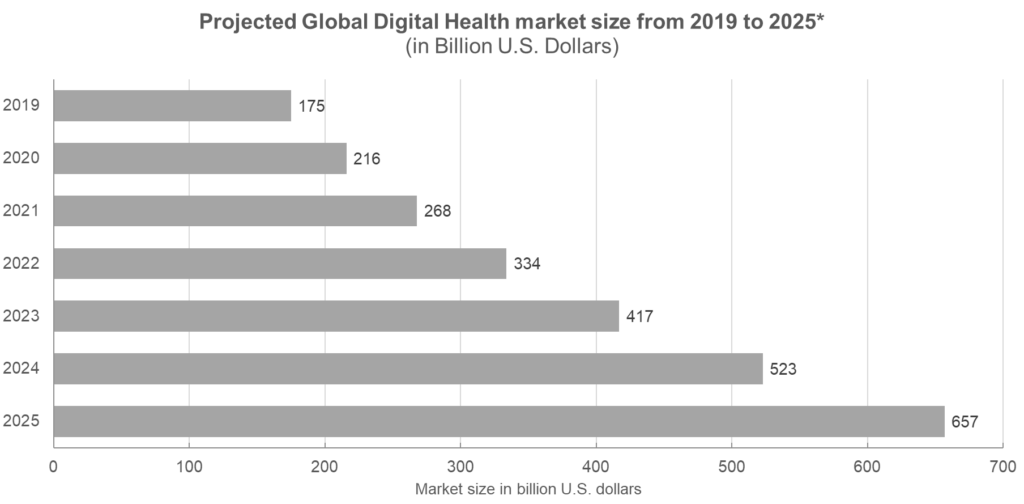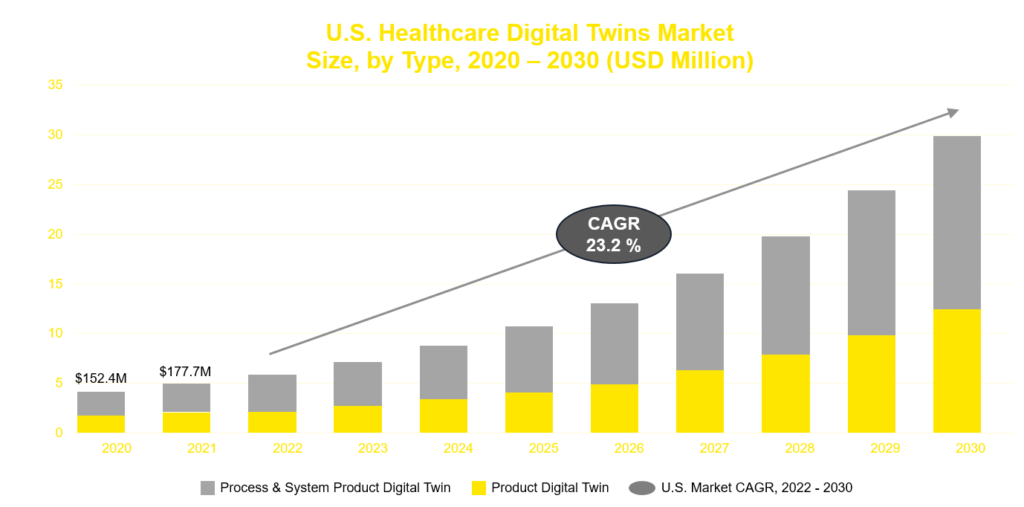Here’s a typical caregiving scene, a patient comes in for medical treatment for recovery and healing. The clear goal is to achieve wholesome healing for the individual from his previous state of disease and illness. Doctors, physicians, and hospital teams intervene with medicines and treatment processes, aiming at the best possible health outcome for the patient. Despite best intentions and careful prescriptions, some ailing ones heal, and others succumb to their case. The medical fraternity is often left high and dry with the question of why some patients survive and heal faster than others. The perennial answer we hear is that every patient is different; it isn’t time that we make healthcare more personalized first, cohesive itself, and convivial at large. This is where creating a digital persona of the patient can benefit hugely. Let’s learn how patient twinning and digital twin (DT) technology is changing patient outcomes in the healthcare industry.
Need for Patient Twinning in Healthcare
The human body is one of the most complex and highly organized structures of hundreds of life processes and billions of life-sustaining cells. Everything has astounding interconnectedness, diverse genetics, and anatomical complexity in structure/behavior. The body’s chemical composition, lymphatic system, enteric nervous system (ENS), endocrine glands, and wellness factors make administering healthcare more convoluted. The patient’s social well-being, mental state, and how they feel having a say in their treatment affect the success of any medical course of action. While deciding on the cure, it is important to closely consider each individual’s unique lifestyle and medical history.
Health conditions of the heart, liver, kidney, nervous system, brain, autoimmune disorders, cancers, and rare diseases are impossible to understand fully. By having access to more historical and real-time information, practitioners become better equipped with valuable clues and can connect medical scenarios. Digital twins can enable the early-stage or prodromal period curing of diseases. With timely advice from the doctor, the sick can be relieved of acute illnesses, life-threatening conditions, surgery, organ transplant, and chemotherapy.
Doctors usually don’t have a complete picture of the patient, and connecting the complex dots is impossible. Patients cannot make complete sense of why and what is happening to them. Most diseases are understood as one of the events. In contrast, there is a possibility that one of the lifestyles led to a chronic problem or a problem with a specific organ is cascading into other health issues. A complete digital simulation of the patient’s medical history and records is now possible with patient twinning and digital twin technology, a ground-breaking development.
Features of Patient Twinning Technology
One way to utilize digital twins is by creating a complete digital patient twin for an in-patient. The digital twin of the patient receives genetic, biological, and sociological data. As a result, the digital twin becomes a complete match for the patient. Along with the chronicled data, the digital twin collects an individual’s health information in real-time and compares this data with specific clinical pathologies, diseases, courses of medication, diagnostic scenarios, and various therapies rendered for affected individuals. With collected evidence and clinical guidelines, both generic and ones put by the doctor, the Digital Twin provides doctors with a holistic, individual, and comprehensive treatment plan for the patient.
Likewise, suppose a complete digital twin is too expensive for someone, according to the medical case. In that case, doctors have access to Artificial Intelligence, Virtual Reality (VR), and Mixed Reality (MR) technologies to create virtual hearts, lungs, kidneys, etc., around the clock. Virtual organs can help determine the progression of diseases over time and respond to new drugs, treatments, and even surgical interventions.
Bracing Use-Cases of Digital Twins Technology
Philip’s dynamic HeartModel provides anatomical intelligence as it tracks every frame over the cardiac cycle using 3D speckle technology and reproduces ejection fraction (EF). This virtual heart increases diagnostic confidence and yields additional clinical information without clinical procedures and inputs. If required, Siemens Healthineers is creating and working on a digital twin of the heart that can digitally simulate cardiac catheter interventions and heart surgery. The digital heart could help doctors tailor cardiological treatment more closely and guide them to proceed if there is a realistic success rate. FEops HEARTguide has created a cloud-based structural heart procedure planning platform using predictive simulation technology and artificial intelligence.
Stryker‘s Blueprint Mixed Reality technology has been built to perform complex shoulder arthroplasty procedures with digital revisions. The software provides 3-D holographic pre-operative plans assisting Orthopaedic surgeons in challenging shoulder arthroplasty cases.
Johnson & Johnson Medical Devices Companies (JJMDC) has partnered with Microsoft to further enhance their digital surgical solutions. JJMDC’s digital offerings, such as surgical robots and medical devices, can derive valuable insights from Microsoft’s Azure-based health cloud. Additionally, they can leverage the digital twin platform for enhanced capabilities.
Radiologists and doctors collaborate closely. AI automatically labels anatomies and creates image biomarkers to differentiate between benign and malignant tissues. Real-life images of the heart using digital twin technology allow surgeons to perform intricate surgeries impossible earlier. Hospitals already generate large volumes of medical imaging data, and digital twin technology can help deduce medical insights.
Faststream Technologies provides a digital twin solution that utilizes big medical data to improve patient diagnosis and treatment outcomes. Their AI-augmented solutions enable physicians to intervene carefully. They achieve this by connecting historical data, including the patient’s medical condition, drug response, physical environment, and lifestyle choices. Additionally, they consider new social exposures, clinical events, and biological responses.
Future of Digital Twin Technology in Healthcare
As per Statista research, the global healthcare digital twins market is projected to reach $ 657 billion by 2025.

Figure 1: Global digital health market size until 2025
Mining healthcare records and digitalizing healthcare scans seem to be the future of the medical profession. Artificial Intelligence will not only help store exabytes of healthcare data but also assist in quickly retrieving healthcare information. According to Royal Bank of Canada (RBC) research, today, Hospitals’ total healthcare data (both digital and offline) amounts to approximately 30% of the world’s data volume, which is projected to have a CAGR of 36% in 2025.

Figure 2: Digital Twins Market Size by 2030
CloudMedx’s ONE platform is an AI-based, fine-tuned Large Language Model (LLM) that simplifies decision-making and ease of operation for all three healthcare stakeholders- the patients, providers, and payers. CloudMedx utilizes a powerful suite of APIs and AI-based apps. These provide a single intuitive interface that addresses concerns related to Machine Learning (ML) integration, scaling, accuracy, and data privacy.
Google DeepMind’s new AI pathways assist in identifying breast cancer before symptoms appear. Thus enabling therapy for the treatable disease. In the double-reading process, the AI simulation maintained non-inferior performance while reducing the second reader’s workload by 88%. AUGMEDIX uses ambient AI technology to convert natural clinician-patient conversations into medical notes and delivers automatic medical documentation for large healthcare systems, clinics, hospitals, and emergency departments. This Artificial Intelligence model will significantly increase patient satisfaction, increase hospital productivity, and improve doctors’ work-life satisfaction.
Limitations & Challenges of Patient Digital Twins
As Digital Twins tech is fairly new and seldom used by the large medical industry, we are yet to see its full impact any time soon. Medium and small healthcare institutions and providers will take years to fully assimilate patient-twinning technology. There are concerns about how well AI & ML will respond consistently to medical data sets, whether large or small. The process of how AI will derive inputs and suggest individual medical plans when comparing individual medical records with massive public records is still uncertain.
The perennial concerns surrounding artificial intelligence and machine learning include AI bias and patients’ data safety. There is the question of how physicians, doctors, and surgeons will make sense of the vast amount of connected information. What will be the ideal course of action when AI suggests something else and the doctor thinks/feels otherwise? We can observe the benefits of increased usage and applied cases of digital twins in various medical procedures. Additionally, we can identify the possible hurdles in adopting MedTech in healthcare.
Conclusion
Digital twins and healthcare AI are fast gaining momentum in the USA, Europe, the UK, and the rest of the world. Artificial Intelligence, Machine Learning, and Mixed Reality (MR) leave no healthcare avenues untouched. Patient twinning creates digital replicas of real humans. It aids in preventive disease diagnosis and precision medical imaging, contributing to improved well-being. Moreover, surgeons and surgeries will become simpler as digital twins bring real-life simulations of human structures and increase the efficiency of all medical staff and doctors.
MR is also boosting robotic surgery, especially for difficult-to-reach and complex surgeries of the heart, digestive system, brain, nerves, and other vital organs. With AI MedTech, patients can feel comfortable and confident about health outcomes. Hospitals and clinics will also see improved patient-doctor interactions, reduced global health costs, and increased focus on preventive measures. For more updates, connect with an expert.